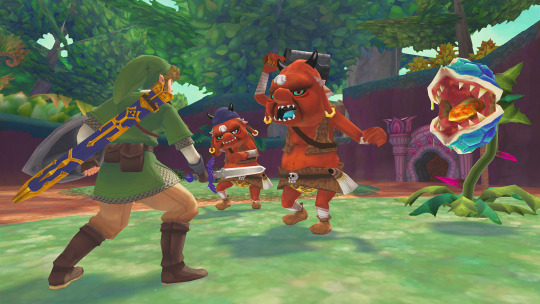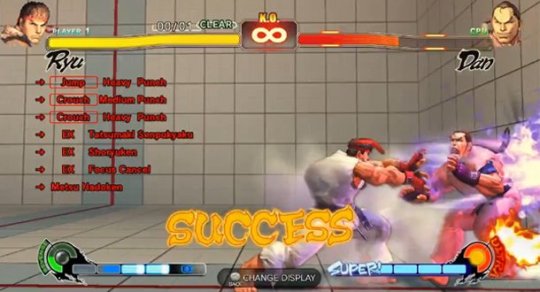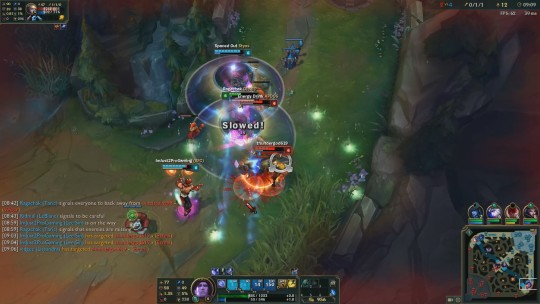Trending
Opinion: How will Project 2025 impact game developers?
The Heritage Foundation's manifesto for the possible next administration could do great harm to many, including large portions of the game development community.
Let's talk about motion controls and Skyward Sword. Let's talk about what some of the fundamental problems with motion controls in Skyward Sword are because I like motion controls.

Skyward Sword isn't the first Zelda game with motion controls -that would be Twilight Princess- but it is the one most defined by them. That is partly because when Twilight Princess was made for both the Wii and the GameCube. That means the game had to be able to work with and without motion controls. This made the motion controls in Twilight Princess largely superficial, where motions just replaced button presses. When it was re-made into HD it didn’t have motion controls at all.
The motion controls in Skyward Sword however are core to the game. You don't just swing the Wiimote horizontally to attack, you can attack in any direction based on how you swing the Wiimote. All the items, levels, and enemies in the game are designed with the Wiimote and motion controls in mind.

Skyward Sword is a good game. A really good game. That isn't to say it doesn't have it's problems -all games do- but I would say that most of the problems people have with the game can be traced back to motion controls.
So let's talk about motion controls and Skyward Sword. Let's talk about what some of the fundamental problems with motion controls in Skyward Sword are because I like motion controls. I think they are great and I'm afraid that the lesson everyone is taking away from this game is that "Motion Controls aren’t that great". That is the wrong lesson. The real lesson is "Motion controls present new problems that need to addressed".
Imagine you are playing a game; you go to doge out of the way of an enemy attack but the attack hits you regardless. Part of you wants to blame the controller for this. This is a natural reaction, you thought you did a thing and that thing didn’t happen. The controller is an easy scapegoat. But you don't really believe that the controller is the problem. You know the problem is that you just didn't press the button fast enough or maybe you pressed the wrong button. You know this because you trust the controller to take your input correctly. You have complete trust in the controller.
When we push the A button we aren't afraid that the controller will accidentally send the signal for the B button. We use the controller with an absolute sense of trust and so when the character doesn't do what we want we know it’s our fault and not the controller’s. That trust is more than vital, it is core. That trust is what allows our minds to move beyond the controller and into the game’s world.
Even if you want to say that motion controls for the Wiimote work 99% of the time -which is a degree of certainly I don’t hear from anyone not trying to sell me one- that 1% is enough to poison the well. That 1% is enough uncertainty as to give that knee jerk complaint about the controller being busted semi-legitimate. You don't know anymore. Did you screw it up or did the controller screw you? Failure is frustrating. It is even more so when that failure isn't our fault, and doubly so when we don't know why that failure happened.

This is a feedback problem. Things are happening/not-happening and the player doesn't know why. Even if we got motion controls 100% accurate at all times without any need for constant calibration and every player trusted them as deeply as they do more classical controllers we would still have a feedback problem. We would still have a feedback problem because the inputs motion controls ask for are so much more complex then a button. A button you simply press, but for motion controls even simple inputs deal with changes in 3 axis of both motion and rotation over time also taking relative screen position into consideration.
To to swing your sword at enemies from any angle in Skyward Sword all you have to do is swing the Wiimote as you would the sword. A lot of the difficulty in the game comes from being able to read an enemy and swing your sword through a gap in their defense. A player might see that the enemy's head isn't protected and swings the Wiimote over their own head in a dramatic downward chop but on screen Link attacks from an angle and the attack bounces off. What happened? Well, while the player's arm was going straight down they were holding the Wiimote at a weird angle and so game decided that what the player was trying to do was attack at an angle, so that is what Link did. The game took in the input correctly and it did what it thought the player wanted it to. But the player doesn't realize that they were holding the Wiimote at an off angle and so the player just thinks that the motion controls are busted.
The problem here is feedback. The player thinks the game didn't take their input properly but it did. The player doesn’t realize they gave it the wrong input though. Given the player input the command incorrectly it would be easy to simply blame the player here and wash our hands of the whole thing. They screwed up right? Come back when you know how to play. But how exactly would they know they screwed up? They moved their arm up straight up and down, yet the game did something else. Without feedback to show them what they did wrong the logical conclusion for the player is that the controller screwed up. How can we expect the player to get better at anything if we never tell them exactly what they are doing wrong? If they have no way of knowing that they are doing something wrong?
The game makes swinging a sword in game to be as easy as swinging a sword in real life. The problem here is I don’t know how to swing a sword in real life, nor am I aware of what my body is doing 80-90% of the time. I can try to swing my arm at a 60 degree angle but God only knows how close I actually got. It is easy for a player to think they input a sword swing or a dance more correctly, but neither of those things are actually easy. The player needs a way to see what they are actually inputting, what their body is actually doing if they are to get better at inputting commands with motion controls.
Most games have very simple inputs. A to jump, B to dash. Fighting games tend to be different though. They will have laboriously long inputs in order to execute special attacks. Half circle left, half circle right, then press these 3 buttons at once. The hardest part of learning these intricate commands is figuring out what you did wrong when they don't work.

In order to help give players clarity into what exactly they are inputting and how they can get better fighting games will include training modes that will show the player exactly what they are inputting and exactly what they are doing wrong. Ideally they would be able to figure out what they are doing wrong mid fight, but that would be a lot of information to feed to a player, let along to 2 players at once, and so they decided to just set aside a special area for learning the complex inputs of the game.
The motion controls for Skyward Sword don't really have that. They have an in world dojo where some of that is possible -you can hit sticks- but it doesn't ever give you the detailed feedback you need in order to figure out why you are having trouble doing an overhead slash or the like. The game never clearly explains to you what about the motion controls matter to the attacks and what doesn't. Do I need to move my whole arm or just my wrist? Does the motion matter or is it just the changing angle of the Wiimote?
Motion controls are complicated. There are 3 different axis for both rotation and movement which we track the change in over time, as well as taking in screen position. This is an incredibly complicated system for inputting commands but the Skyward Sword treats it like it is something that is so simple explanations of it aren't really necessary. How do you swing your sword? Swing the Wiimote! Tutorial over.
But we need to know what about how we swing the Wiimote matters and what doesn't. It it just a rotational thing? Do I just need to move my wrist? Is movement taken into consideration or is it just a rotation thing? Should I do it with my whole arm? Would that help? What about screen position, and how fast should I be do it? The game doesn't answer these questions, nor does it doesn't provide you with clear in game feedback as to why it did an overhead attack when you were trying to do one at an angle.
Without insight as to how the game is translating our inputs we have no idea if it is doing it correctly. From a player's perspective, sometimes it works and sometimes it doesn't. Given player’s already don’t trust the system to accurately record their movements every attack in Skyward Sword feels like a gamble because even if you know what you want to input who knows what the game will do?
Here is a common situation in a game: your attack gets blocked which puts you into a stunned state. While your character runs through their little stun animation you see that the enemy has dropped their guard and so you want to attack again as soon as possible. You don't know exactly how long the stunned state will last though, so you just start spamming the attack button. That way whenever you can attack again, you will.
The player not knowing exactly when they will be able to attack again is a problem of conveyance. The game isn't clearly communicating when you are/aren't in control. It doesn't usually matter to much, as I said before you can just spam attack, dodge, guard, or whatever while you wait to get control back. In Skyward Sword though you attack by moving your entire arm in a mock sword swing. This isn't something you can rapidly spam while waiting to get control back.
Even if that stun state only lasts a fraction of a second it gets extra time automatically added to it as the player will wait far longer then they need to just because they don't want to swing their arm when it will do nothing or worse when they might only input half a swing which the game might misconstrue somehow.
Players will be more hesitant, and they will be confused as to what is happening moment to movement. This makes the game feel slower and clunkier. In most games this is a small failure of conveyance that doesn't actually matter, but in a game like Skyward Sword it matters a lot. Telling the player exactly when they are/aren't in control becomes much more important because now inputting commands takes a noticeable amount of time and energy.

This is a solvable problem, even if they wanted to avoid having large noticeable bars on the screen that show you exactly how much time is remaining. Perhaps they could of had the controller rumble a little bit when they got control back. The player would get their arm in position and ready to attack, and when they feel that small rumble they can attack. It would be a small thing but it would give the player the information they needed to attack confidently and quickly.
There are a lot of games that have solutions for this problem, but we are only used to having to convey such information in hyper competitive games where that degree of information is necessary. Motion controls are different on a fundamental level though. They bring a lot of nuance to the player’s ability to control their avatar, but they also bring new problems.
I don't want anyone to come away from this thinking that motion controls are unworkable. They have clear problems. Not just technical problems, but design and user interface problems. These problems though are solvable. Mostly solvable. There will always be things that buttons are better for, but the promise of motion controls is so great that even if we don't come up with perfect solutions so long as we can do it well enough to be able to sell the amazing fantasy of motion controls then that is going to be enough. Because whatever problems motion controls have they also have an amazing fantasy. The fantasy of having our actions directly translated into the game world, of being in that world.
Motion Controls are complicated. This is something that should be self evident, but I'm not sure everyone really gets that. Maybe everyone got that they are technologically complicated but they are also complicated from a game design standpoint. There is so much more information to process and so much more information that we need to send back to the player as a result. As game designers we need to figure out how to give the player that information quickly and cleanly if we are to create trust in the controls,
My concern is that when motion controls didn't instantly work like people hoped that they would, that people just decided that the problem was just that motion controls aren't actually all that great. Sure they sound nice, but in practice they just don't work. This is the wrong lesson. There are problems, of course, but they are solvable problems. More than that though, they are worth solving.
Read more about:
BlogsYou May Also Like